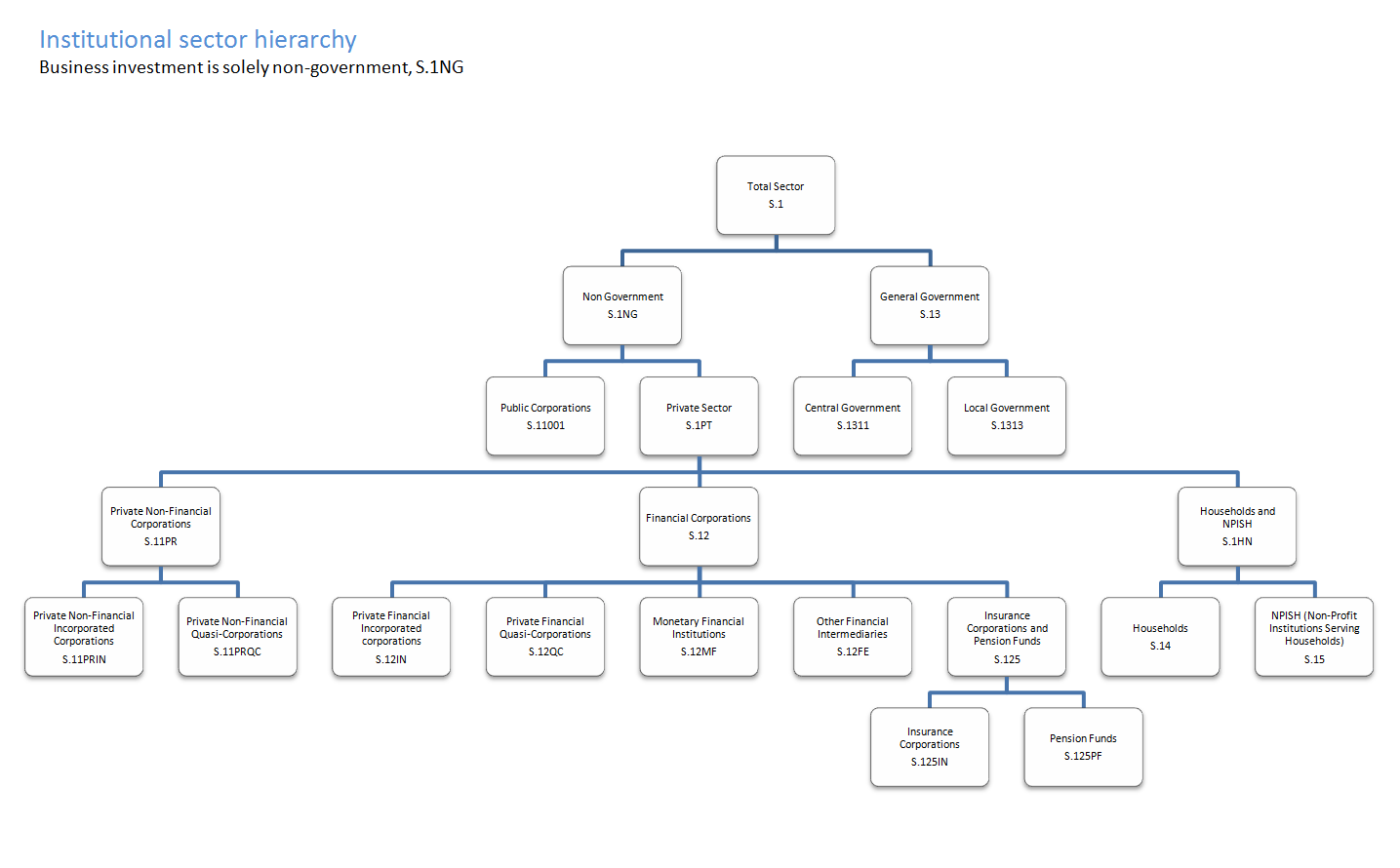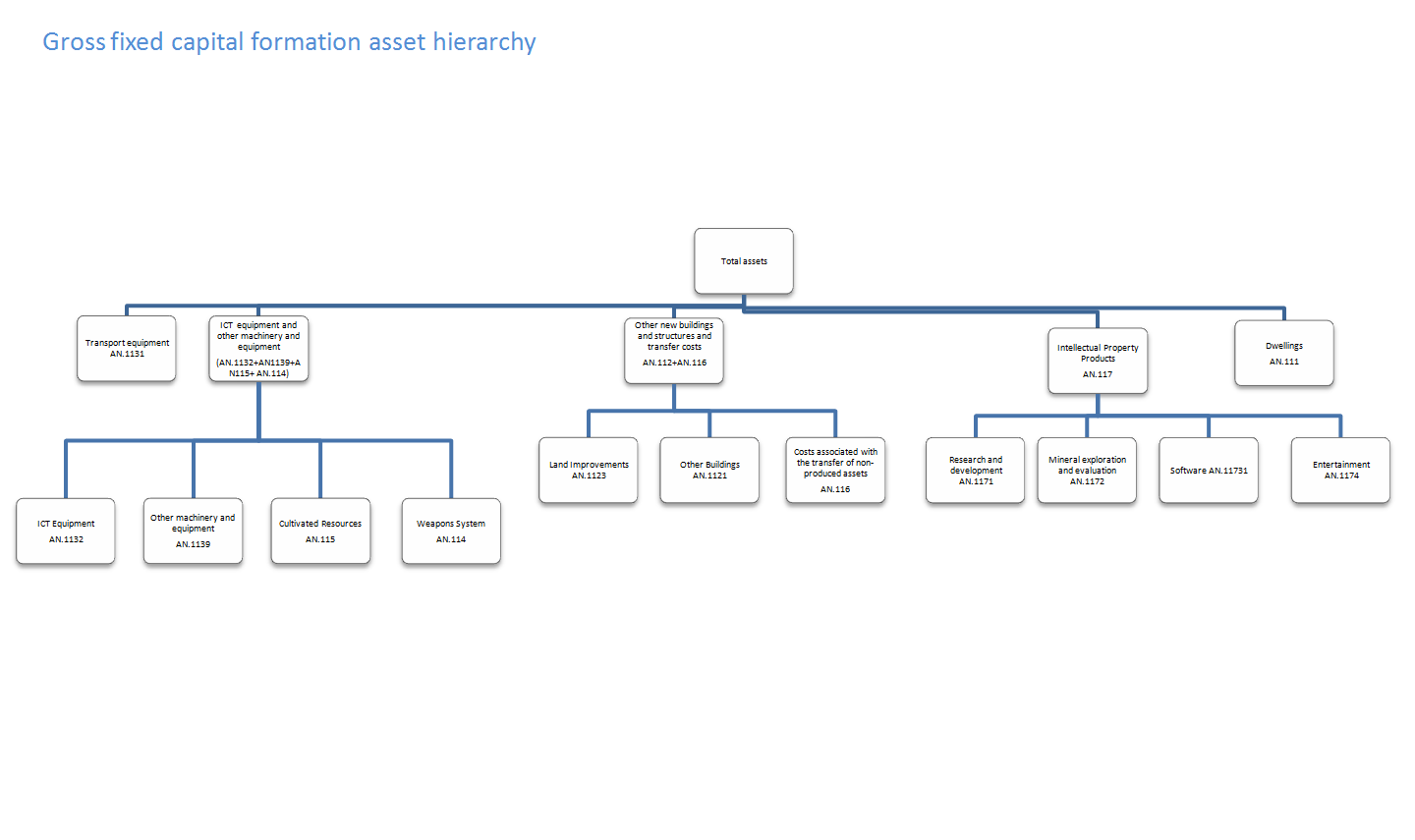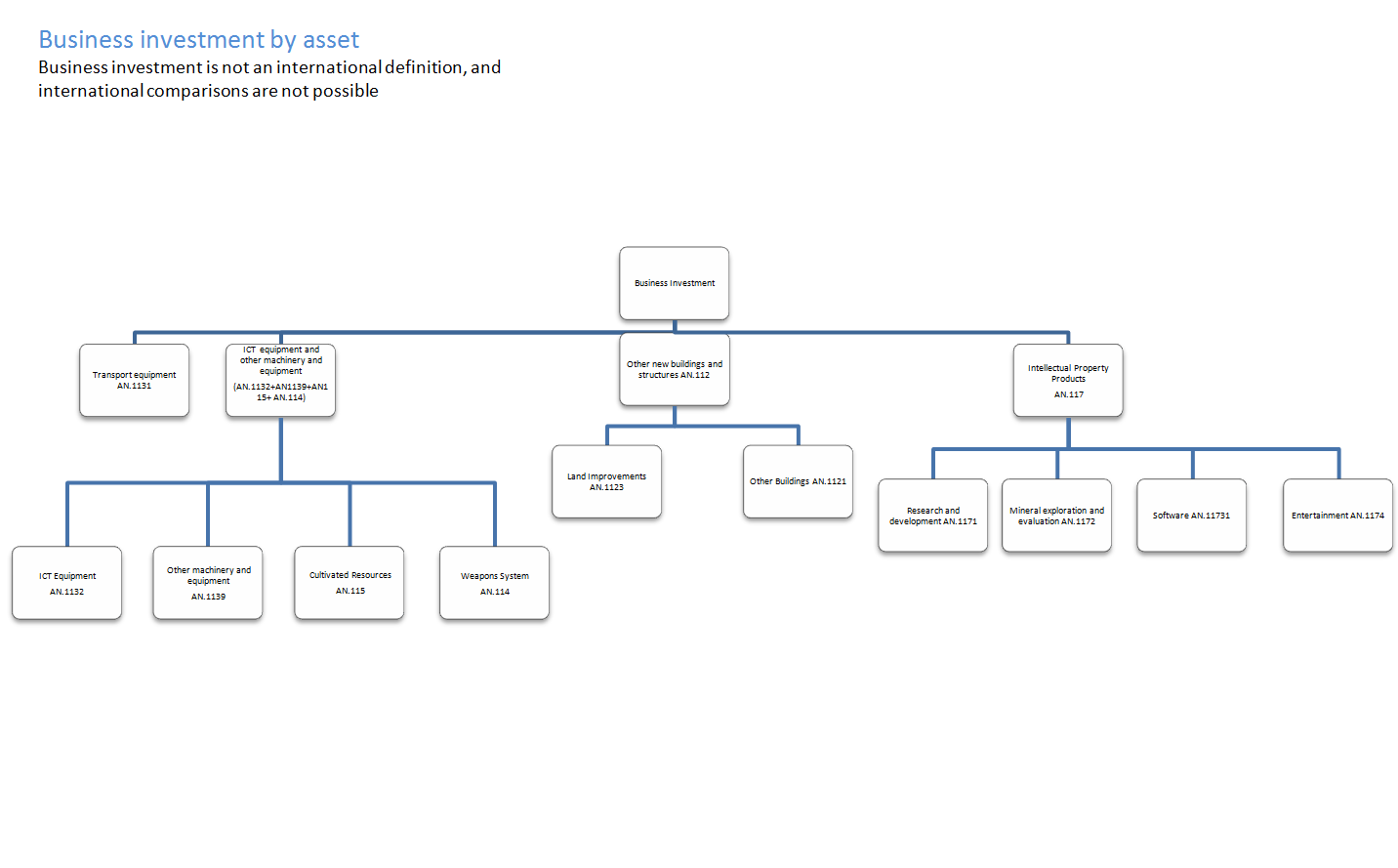1. Main points
These estimates are short-term indicators of investment in assets, such as dwellings, transport equipment, machinery, buildings and intangible assets. This release covers asset breakdowns of total gross fixed capital formation (GFCF), of which business investment is one component
All investment data referred to are estimates of seasonally adjusted chained volume measures
In Quarter 3 (July to Sept) 2015, GFCF was estimated to have increased by £0.6 billion (0.7%), compared with the previous quarter, to £77.4 billion. This is the highest level since Quarter 4 (Oct to Dec) 2007
In Quarter 3 (July to Sept) 2015, business investment was estimated to have increased by £1.0 billion (2.2%), compared with the previous quarter, to £44.6 billion
In Quarter 3 (July to Sept) 2015, GFCF was estimated to have increased by 3.4% compared with Quarter 3 (July to Sept) 2014
In Quarter 3 (July to Sept) 2015, business investment increased by 5.8% compared with Quarter 3 (July to Sept) 2014
The earliest period being revised in this release is Quarter 1 (Jan to Mar) 2014
2. About this release
The estimates in this release are short-term indicators of investment in non-financial assets in the UK, such as dwellings, transport equipment, machinery, buildings and intellectual property products. This release covers not only business investment, but asset and sector breakdowns of total gross fixed capital formation (GFCF), of which business investment is one component.
Business investment is net investment by private and public corporations, these include investments in:
transport
information, technology and communications (ICT) equipment
other machinery and equipment
cultivated assets
intellectual property products (IPP, which includes investment in software, research and development, artistic originals and mineral exploration)
buildings and other structures
It does not include investment by central or local government, investment in dwellings or the costs associated with the transfer of non-produced assets (such as land). A full sector and asset hierarchy can be found in the background notes. Note that business investment is not an internationally recognised concept and therefore it should not be used to make international comparisons.
All investment data referred to in this bulletin are estimates of seasonally adjusted chained volume measures.
Nôl i'r tabl cynnwys3. Changes to the Quarterly Survey of Capital Expenditure and methodological information
Changes to the Quarterly Survey of Capital Expenditure in Quarter 1 (Jan to Mar) 2015
As described in the Business Investment, Quarter 4 (Oct to Dec) 2014 Revised Results bulletin and in Changes to the Annual Business Survey, the Quarterly Survey of Capital Expenditure and the Survey into Business Spending on Capital Items, in 2015 (114.3 Kb Pdf), we moved to the Quarterly Acquisitions and Disposals of Capital Assets Survey (QCAS) from the Quarterly Survey of Capital Expenditure (CAPEX). The main reason is to move to the updated European System of Accounts (ESA) 2010 manual, the international guidance for national accounts.
The main changes to the survey are:
adding new questions to improve the quality of our estimates and to meet the latest European legislation requirements (ESA 2010)
removing the lower limit of £500 for the value of reported assets, so all relevant assets (even those below businesses’ Asset Register threshold) can be reported
including small tools used in production in the definition of GFCF
improving the questionnaire’s layout, including new sections and headings, to make completing the questionnaire easier
The data from the new questions will not be included in estimates of GFCF and its components until 2017, when there will be 2 years of data available for quality assurance.
Further methodological information including changes to the UK National Accounts
Estimates in this release have been compiled under ESA 2010 concepts and definitions, in compliance with the UK’s legal obligations in producing the National Accounts. Articles are available describing the methodology used to estimate GFCF and the impact of the changes implemented for ESA10 in September 2014.
On 19 May 2015 we published several articles explaining the changes that were implemented in the UK National Accounts (Blue Book) 2015, published 30 October 2015. These articles describe changes related to ongoing work to meet ESA 1995 requirements. These include changes that impact GFCF and its components, specifically spending on repairs and maintenance of dwellings and exhaustiveness. There is a comprehensive list of all published articles relating to changes to the UK National Accounts (Blue Book).
Nôl i'r tabl cynnwys4. Gross fixed capital formation and business investment
Figure 1: Annual gross fixed capital formation chained volume measures
Reference year: 2012 Coverage: UK
Source: Quarterly Acquisitions and Disposals of Capital Assets Survey - Office for National Statistics
Notes:
- The data in this chart covers 1998 to 2014.
Download this chart Figure 1: Annual gross fixed capital formation chained volume measures
Image .csv .xls
Figure 2: Quarterly gross fixed capital formation chained volume measures, seasonally adjusted
Reference year: 2012 Coverage: UK
Source: Quarterly Acquisitions and Disposals of Capital Assets Survey - Office for National Statistics
Notes:
- Q1 = Quarter 1 (January to March), Q2 = Quarter 2 (April to June), Q3 = Quarter 3 (July to September), Q4 = Quarter 4 (October to December).
- The data in this chart covers Quarter 3 (July to Sept) 1997 to Quarter 3 (July to Sept) 2015.
Download this chart Figure 2: Quarterly gross fixed capital formation chained volume measures, seasonally adjusted
Image .csv .xls
Figure 3: Annual business investment chained volume measures
Reference year: 2012 Coverage: UK
Source: Quarterly Acquisitions and Disposals of Capital Assets Survey - Office for National Statistics
Notes:
- The data in this chart covers 1998 to 2014.
Download this chart Figure 3: Annual business investment chained volume measures
Image .csv .xls
Figure 4: Quarterly business investment chained volume measures, seasonally adjusted
Reference year: 2012 Coverage: UK
Source: Quarterly Acquisitions and Disposals of Capital Assets Survey - Office for National Statistics
Notes:
- Q1 = Quarter 1 (January to March), Q2 = Quarter 2 (April to June), Q3 = Quarter 3 (July to September), Q4 = Quarter 4 (October to December).
- The data in this chart covers Quarter 3 (July to Sept) 1997 to Quarter 3 (July to Sept) 2015.
Download this chart Figure 4: Quarterly business investment chained volume measures, seasonally adjusted
Image .csv .xlsFigure 4 shows a large spike in business investment in Quarter 2 (Apr to June) 2005. This is due to the transfer of British Nuclear Fuels Ltd (BNFL). In April 2005, nuclear reactors were transferred from BNFL to the Nuclear Decommissioning Authority (NDA). BNFL is classified as a public corporation in National Accounts, while the NDA is a central government body. The business investment series includes investment by public corporations, but not government spending, the positive spike reflects the £15.6 billion transfer. More information on the transfer of BNFL can be found in section 3 of the background notes.
Summary tables
In Quarter 3 (July to Sept) 2015, total gross fixed capital formation increased by an estimated £0.6 billion (0.7%) compared with the previous quarter. Business investment saw an increase of 2.2%, rising by an estimated £1.0 billion. This increase was partially offset by a decrease in private sector dwellings of an estimated £0.4 billion (2.4%).
Table 1a: Total gross fixed capital formation in the UK by institutional sector, Quarter 3 (July to Sept) 2015
| % change | £ million | |||
| Most recent quarter on previous quarter | Most recent quarter on a year earlier | Most recent level ** | Level change from previous quarter | |
| Gross fixed capital formation | 0.7 | 3.4 | 77,415 | 567 |
| Business investment | 2.2 | 5.8 | 44,582 | 974 |
| General government | -0.9 | 1.6 | 11,782 | -112 |
| Public corporations dwellings | 3.0 | 14.4 | 1,000 | 29 |
| Public corporations cost of ownership transfer on non-produced assets | 6.2 | -1.3 | -155 | -9 |
| Private sector dwellings | -2.4 | -0.6 | 15,287 | -378 |
| Private sector cost of ownership transfer on non-produced assets | 1.3 | -2.7 | 4,919 | 63 |
| Source: Office for National Statistics | ||||
| Notes: | ||||
| 1. ** Series may not sum to totals due to rounding. | ||||
Download this table Table 1a: Total gross fixed capital formation in the UK by institutional sector, Quarter 3 (July to Sept) 2015
.xls (26.6 kB)In Quarter 3 (July to Sept) 2015, information and communications technology (ICT) equipment and other machinery and equipment saw the largest level increase, rising by an estimated £0.8 billion (5.6%). Other buildings and structures and transfer costs saw the second highest level increase of an estimated £0.5 billion (2.0%). These increases were partially offset by a decrease in dwellings of an estimated £0.4 billion (2.1%). All assets showed positive growth compared with the same quarter of the previous year.
Table 1b: Total gross fixed capital formation in the UK by asset, Quarter 3 (July to Sept) 2015
| % change | £ million | |||
| Most recent quarter on previous quarter | Most recent quarter on a year earlier | Most recent level ** | Level change from previous quarter | |
| Gross fixed capital formation | 0.7 | 3.4 | 77,415 | 567 |
| Transport equipment | -5.9 | 15.4 | 3,811 | -241 |
| ICT equipment and other machinery and equipment | 5.6 | 2.7 | 15,918 | 847 |
| Dwellings | -2.1 | 1.0 | 16,479 | -351 |
| Other buildings and structures and transfer costs | 2.0 | 4.7 | 24,647 | 491 |
| Intellectual property products | -1.1 | 2.0 | 16,560 | -179 |
| Source: Office for National Statistics | ||||
| Notes: | ||||
| 1. ** Series may not sum to totals due to rounding. | ||||
Download this table Table 1b: Total gross fixed capital formation in the UK by asset, Quarter 3 (July to Sept) 2015
.xls (26.6 kB)5. Economic background
Gross fixed capital formation (GFCF) grew by 3.4% year on year in Quarter 3 (July to Sept) 2015, continuing a downward trend in investment growth since the post-economic downturn high of 8.6% in the second quarter (Apr to June) of 2014. This trend is also seen in the corresponding growth of GDP, which has declined from 3.0% in Quarter 2 (Apr to June) 2014, the highest since the downturn, to 2.1% in the latest quarter. On average, quarter on quarter a year ago growth in GFCF has declined by around 1% each quarter since Quarter 2 (Apr to June) 2014.
Business investment grew by 2.2% on the previous quarter, bringing its share of total GFCF to 57.6%, a proportion last seen in early 2013 and higher than the average since 2007 of 55.4%. This in turn raises the business investment share of GDP to 10% in Quarter 3 (July to Sept) 2015, up from an average of 9.5% during 2014 and 9.3% in 2013. Business investment as a share of GDP has not been as high as it is now since before the downturn. The growth in business investment was a main factor in pushing up total GFCF growth to 1.6% in Quarter 2 (Apr to June)2015, compared with the previous quarter and was an important contributor to GDP growth in the second quarter.
The annual rate of business investment growth increased from 3.6% last quarter to 5.8% in Quarter 3 (July to Sept) 2015 – a step up from the average growth rate of 5.3% since mid-2013. The relatively strong position of business investment growth and contribution to the growth of both wider investment and GDP is also reflected in the Bank of England’s Credit Conditions Survey, which indicates that total net finance raised by UK businesses remains positive, in particular due to increasing availability of credit to small and medium enterprises (SMEs); while larger companies reported borrowing conditions comparable to those before the downturn.
All asset classes increased on the year, the largest contributor being other buildings and structures and transfer costs, which grew by 4.7% in Quarter 3 (July to Sept) 2015. Investment in dwellings grew by 1% and contributed 0.2 percentage points to GFCF growth. The growth in investment in infrastructure, buildings and housing is supported by the Bank of England’s Agents’ Summary, which echoed the positive (but easing) pace of house-building and infrastructure activity, reporting that non-bank finance continues to flow into the commercial real estate market, with occupier demand rising further.
Nôl i'r tabl cynnwys6. Where to find more of our data
We also publish additional analyses of GFCF, business investment, and the Quarterly Acquisitions and Disposals of Capital Assets Survey, which have been created in response to ad hoc user requests. These are available to download free from our website. Enquiries about ad hoc requests may be made to gcf@ons.gov.uk.
Nôl i'r tabl cynnwys7. Adjustments, revisions and response rates
Adjustments
Large capital expenditure tends to be reported later in the data collection period than smaller expenditure. This means that larger expenditures are often included in the revised (month 3) results, but are not reported in time for the provisional (month 2) results, leading to a tendency towards upwards revisions in the later estimates for business investment and gross fixed capital formation (GFCF). Following investigation of the impact of this effect, from Quarter 3 (July to Sept) 2013, a bias adjustment was introduced to GFCF and its components in the provisional estimate. A bias adjustment of £0.5 billion was included in the provisional (month 2) release for Quarter 3 (July to Sept) 2015. This has been removed for the revised (month 3) release.
The Quarterly Survey of Capital Expenditure was improved by adding clearer instructions. As detailed in the provisional Quarter 1 (Jan to Mar) 2015 Business Investment release, feedback from some respondents indicated that they had been misreporting their asset breakdown and were correcting this on the new questionnaire. We found that some respondents were reporting new construction work (NCW) as other capital equipment (OCE). From Quarter 1 (Jan to Mar) 2015 respondents to the survey are now reporting more in new construction work at the expense of other capital equipment.
In order to remain consistent with the previous data, we have made some adjustments to the assets in the current price series in Quarter 1 (Jan to Mar), Quarter 2 (Apr to June) 2015 and Quarter 3 (July to Sept) 2015. As there has been no further significant response to Quarter 1 (Jan to Mar) 2015, the quality adjustment of -£1.5 billion applied to asset buildings and +£1.5 billion to other machinery remains unchanged, from the provisional release. As further response in Quarter 2 (Apr to June) 2015 and Quarter 3 (July to Sept) 2015 have changed the asset mix further, we have applied adjustments of -£2.1 billion to asset buildings and +£2.1 billion to other machinery in Quarter 2 (Apr to June) 2015, and -£1.9 billion to asset Buildings and +£1.9 billion to other machinery in Quarter 3 (July to Sept) 2015. These adjustments will be reviewed as the survey response increases.
Revisions
Data in this release has been revised from Quarter 1 (Jan to Mar) 2014 to Quarter 3 (July to Sept) 2015. We have taken the opportunity to include revised current price data from several data sources, such as local communities’ data which affects dwellings, quarterly survey data which affects all assets, and government data. We have also reviewed our currently forecasted research and development data, which has an impact on intellectual property products. As well as the impact from current price revisions, chain-linked estimates have been affected by the inclusion of more up-to-date deflators especially for legal activities and entertainment. Revisions to all assets and sectors can be seen in the accompanying revisions tables at the end of this release.
Survey response rates
Table 2 presents the revised (month 3) response rates for the Quarterly Acquisitions and Disposals of Capital Assets Survey (QCAS). The estimates in this release are based on the Quarter 3 (July to Sept) 2015 month 3 (revised) survey results.
Table 2: UK response rates for quarterly acquisitions and disposals of capital assets survey, Quarter 3 (July to Sept) 2014 to Quarter 3 (July to Sept) 2015
| Period | Survey response rates At month 2 (Provisional) | Survey response rates At month 3 (Revised) | |
| 2014 | Q3 | 78.7 | 91.7 |
| Q4 | 80.1 | 94.4 | |
| 2015 | Q1 | 67.3 | 88.8 |
| Q2 | 70.8 | 88.5 | |
| Q3 | 72.1 | 84.1 | |
| Source: Office for National Statistics | |||
| Notes: | |||
| 1. Q1 is Quarter 1 (Jan to Mar). | |||
| 2. Q2 is Quarter 2 (Apr to June). | |||
| 3. Q3 is Quarter 3 (July to Sept). | |||
| 4. Q4 is Quarter 4 (Oct to Dec). | |||




